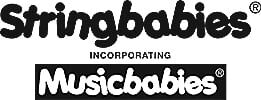Stringbabies Cello Book review, in ARCO by ESTA Sept 2013

The new Stringbabies ‘cello pupil’s workbook and parent’s/teacher’s book are simple to follow and well laid out.
They feature an eye catching cover design which replaces the previous version. The new ‘cello pupil’s workbook also comes with a CD of piano accompaniments which features both practice and performance tracks. Each piece in the pupil’s workbook is presented in large print using the unique Stringbabies notation system.
It is clear, easy to follow and very accessible for young children. Each piece builds on skills already learned, and the book takes a child from using open strings to the beginnings of fourth position. Rhythms and bowing are also addressed, and children are encouraged to write their own pieces.
While this book is aimed at the younger child, the Stringbabies system can also be used to help those with learning challenges, dyslexia and also adults who are new to reading music and learning an instrument.
Stringbabies aims to give a simple and clear introduction to the cello and general musicianship and achieves just that. It gives an effective and secure framework within which to work, and the pieces can be supplemented with other beginner repertoire.
Having used this system with pupils for 6 years, the benefits are clear. Pupils understand what they are doing and why they are doing it which gives them confidence. They learn while having fun and in a natural way.
Allyxa Ruby
ARCO (ESTA- European String Teachers Association)

Stringbabies Violin Book review, in ARCO by ESTA Sept 2013

Within her latest edition of Stringbabies, Kay has developed her initial work based on the expectation that reading and composition is introduced alongside the earliest experience of creating string sounds.
It is aimed initially for beginner pupils from the age of 3 years, in an updated edition to include CD. With great relevance for teaching of reading generally, or to support remedial issues, the latest edition was published in February 2013 as the result of a request from Surrey Arts.
As the National Plan for Music emerges to provide for the youngest pupils from Yr 1, Kay’s system developed through her teaching over the last 8 years seems very relevant. In fact as music services and private teachers explore the strategies available for this age group, the framework is being extended and trialled in versions for recorder and very soon the flute under the collective title of Musicbabies.
In her forward, Pat Legg describes the approach as ‘an educationally well thought out and fun way of teaching little ones which systematically gives them the skills they need to read music and become musicians.’ She also comments on the success Kay has had with teaching this method and how parents and pupils can ‘enjoy the journey of discovery and see how the reading of music opens up so many musical delights’.
Using experts for each instrument the framework for notation recognition uses a simple system of magnetic symbols to match open strings or starting sounds for each instrument by shape.
This enables pupils to identify and control the choice of sounds from the very beginning. It is expected that the pupil becomes a composer alongside being a reader and player. It is not a chore but a creative discovery. Rhythms are taught initially using Ta, Te Te, Ta- a extending to Ti-ka Ti-ka , Te—ti- ka and Ti-ri-li is introduced for compound time.
Using the original symbols the range is then extended up each string through simple progressive tunes. The notation is transferred on to 2 and then 3 line staves which are then extended to the conventional 5 lines as the understanding develops; (harder for the teacher than the pupil!) By the end of the book notated tunes on 5 lines covering 3 finger patterns on each string have been secured and a framework for G, D and A majors covered.
There are some nicely spaced blank user friendly staves in the pupils book for original compositions and explorations with newly discovered pitches and rhythms. The memorable tunes; a mixture of original favourites such as Kippers and Custard and Hello song are introduced by singing and are reinforced by the Kodaly principles of hand signals. Jimmy Giraffe takes us effortlessly to 6/8.
Allyxa Ruby
ARCO (ESTA- European String Teachers Association)
